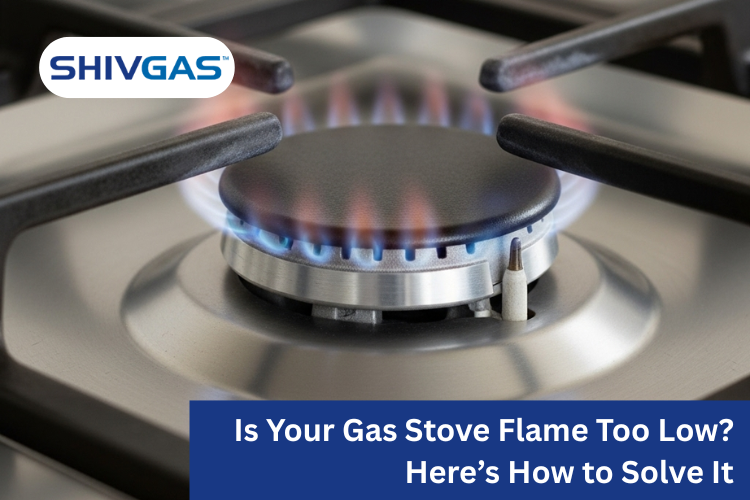
Have you ever stood impatiently by your stove, wondering why your tea is taking forever to boil or why your curry refuses to simmer properly? If so, you’re not alone. A low gas flame is one of the most common yet often overlooked issues in Indian kitchens today.
While it may seem like a minor inconvenience, the LPG gas stove's low flame problem can actually point to deeper performance, maintenance, or safety concerns. Whether you're trying to reheat leftover food, sauté vegetables, or cook a full meal, a weak flame delays the process and leads to undercooked food. More importantly, it may lead to a serious issue with your LPG gas stove setup.
In this blog, you will get an idea about the causes, fixes, and preventive steps for the low gas flame issue in LPG stoves. From basic LPG setup knowledge to advanced troubleshooting, this document has got it all covered.
LPG is a clean and highly efficient cooking fuel. It is normally used in domestic kitchens, particularly in urban and suburban households. It is mainly made up of propane and butane gas, stored under pressure in cylinders.
Let us know about the different components of an LPG gas stove.
Any disruption in this chain can cause low gas flame issues on the gas stove.
So, how will you know if you’re facing the LPG gas stove low flame problem? There are some common indicators that make you aware of the same.
If any of this sounds familiar, keep reading. You might be just a few steps away from fixing the issue.
Several day-to-day and technical reasons could be responsible for the low gas flame in your stove:
Food spills, grease buildup, and dust can block the tiny holes on the burner, which can reduce flame intensity.
Faulty regulators or nearly empty cylinders may minimize gas pressure, leading to a weak flame output.
The regulator controls the pressure and flow of gas. If it has become old or damaged, it may not deliver enough gas to the stove.
If the hose is kinked, damaged, or loosely attached, the flow of gas is restricted.
If too much air is mixing with the gas (or too little), it can disrupt the burning process and result in poor flame quality.
Before you book a service appointment or buy a new appliance, here are a few DIY checks and fixes that might restore your low gas flame:
Turn off the gas, remove the burner caps, and use a pin or fine wire to unclog the holes. Don’t forget to dry the parts completely before reassembling.
Inspect if the pipe is bent, rusty, cracked, or loosely attached. Replacing it with a new ISI-approved hose usually fixes half the problem.
Make sure the regulator is tightly fitted to the cylinder. If loose or worn out, it should be replaced urgently.
If you suspect your cylinder is on the verge of running out of gas, give it a gentle tap. A hollow sound usually indicates it's nearly empty.
Most burners have an air shutter beneath. Adjust it to find the right air-gas mix. A properly balanced mix gives a strong blue flame.
If the above fixes don’t work, it’s time to get a technician involved. Problems such as internal pipeline blockages or faulty valves must be addressed by certified gas appliance professionals only.
You should seek professional assistance if:
This is a common case in dual or triple burner stoves. If only one burner has a weak flame, swap the burners and see if the problem follows the part. If it does, the issue lies in the burner unit. If it doesn’t, you might be dealing with a blocked internal pipeline.
Prevention is always better than cure. Here’s how you can avoid future LPG gas stove low flame problems:
During winter or in cold climates, LPG gas does not vaporize as quickly, resulting in low gas flame performance.
You may also like: 3 Common Gas Stove Problems And Ideas How To Fix It
The low gas flame issue on an LPG gas stove is more than just a cooking nuisance—it’s a message from your appliance telling you something’s wrong. Whether you're preparing breakfast for your family or running a small food stall, a strong and healthy flame is your best friend in the kitchen.
In a country like India where LPG remains the primary cooking fuel in most households, being aware of these everyday technicalities can not only improve your cooking efficiency but also ensure the safety of your home.
So the next time your stove flickers, sputters, or cooks too slow, no need to panic. Take a closer look. If the problem persists, take recourse to a professional before it's too late.
Ans. A sudden drop in flame can be caused by a partially closed regulator, an almost empty gas cylinder, clogged burner holes, or a loose hose connection restricting gas flow.
Ans. Turn off the gas supply, remove the burner caps, and clean the holes using a pin or brush to remove debris. Wash with warm soapy water, then dry and reassemble.
Ans. No. A yellow or orange flame indicates incomplete combustion, which can release carbon monoxide. This should be addressed immediately by cleaning or checking the gas-air mix.
Ans. For optimal performance and safety, it's recommended to clean burners monthly and have your stove, hose, and regulator professionally checked at least once a year.
Comment (0)